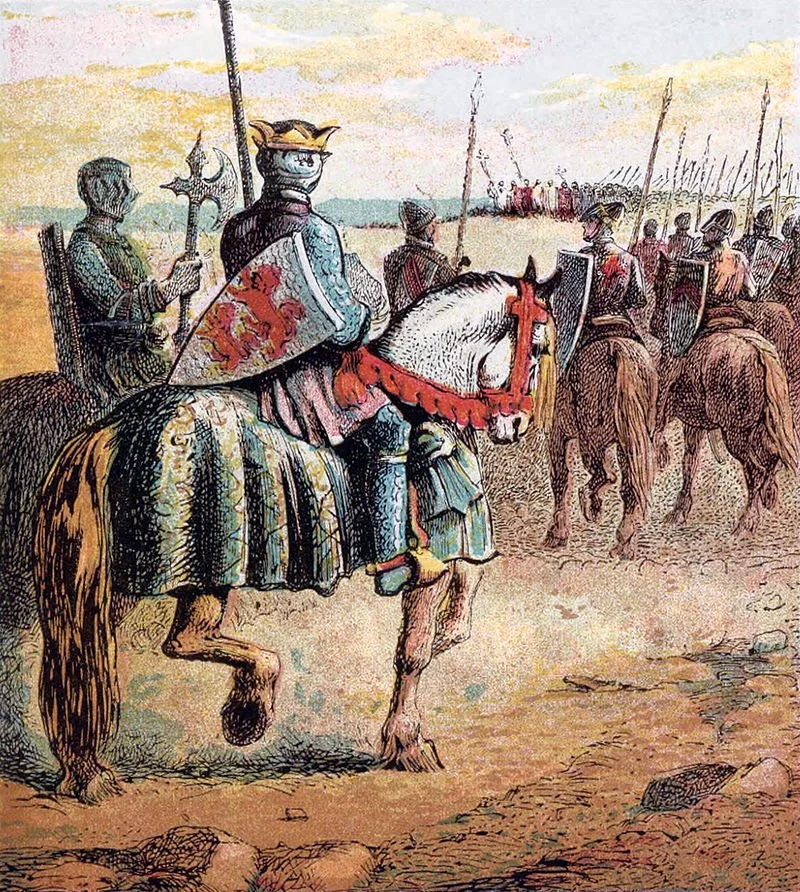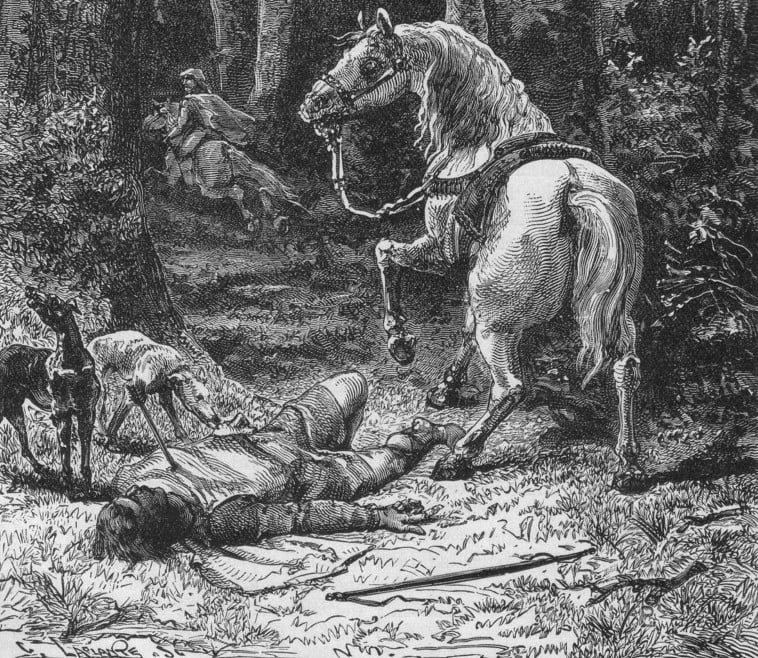King William Rufus the Unpopular Norman King of England
King William Rufus was the third, and possibly favourite son of the Norman conqueror William I. After an unusual set of circumstances, William inherited the throne of England at the age of 30, despite having two older brothers, Robert and Richard.
Due to his red hair and fiery temperament, William had the sobriquet William Rufus or William the Red. Then, as king, he gained the third title William II of England. He was an unpopular king, especially with the church, as he showed little piety or morality. But as a great soldier, William continued in his father's footsteps to push the Norman occupation across England. However, feuds between William and his older brother caused instability throughout the reign.
| Born | 1056, Normandy |
| Parents | William the Conqueror & Matilda of Flanders |
| Married | No |
| Children | None |
| Died | 2 August 1100, New Forest, Hampshire (43) |
| Reign | 1087 - 1100 (12) |
| Crowned | 26 September 1087, Westminster Abbey (30) |
| Predecessor | William I the Conqueror (father) |
| Successor | Henry I (brother) |
| House | Norman |
Life Events of William II Rufus
1056
William Rufus is born, the third son of William the Conqueror and Matilda of Flanders.
1087
Following the death of his father, William Rufus succeeds him as the King of England. His older brother, Robert Curthose, inherits the title of Duke of Normandy.
1087
On 26 September, William Rufus is crowned as the King of England at Westminster Abbey.
1088
William faces a rebellion led by his older brother, Robert Curthose, who seeks to claim the English throne. The rebellion is ultimately unsuccessful, and William maintains his rule.
1097
King William II Rufus commissions the construction of Westminster Hall, a grand medieval hall that will become the centerpiece of the Palace of Westminster in London. The hall still stands today.
1100
On 2 August 1100, King William II Rufus meets an untimely death while hunting in the New Forest. The exact circumstances of his death remain unclear, but there are theories suggesting foul play.
Interesting Facts About King William II Rufus
Epithet
William II was commonly known as ‘Rufus’ due to his red or reddish-brown hair. The nickname ‘Rufus’ means ‘the Red’ in Latin.Church
William Rufus had a contentious relationship with the Church. He clashed with several church leaders, including Anselm of Canterbury, over issues of governance and the appointment of bishops.Hunting
William Rufus was an avid and passionate hunter. He spent a significant amount of time pursuing various game, particularly in the New Forest. His love for hunting ultimately led to his untimely death.Death
William Rufus' death in 1100 while hunting in the New Forest remains shrouded in mystery. The exact circumstances are unclear, there have been speculations of foul play or accidental shooting.Arts
Despite his contentious reign, William Rufus was known for his patronage of the arts. He sponsored the construction of several grand buildings, including Westminster Hall, and supported various artistic endeavors.Finance
William Rufus was notorious for his extravagant lifestyle and excessive spending. He often resorted to heavy taxation and selling political offices to fund his lavish lifestyle and military campaigns.Feud
William Rufus had a long-standing rivalry with his older brother, Robert Curthose. Their conflict culminated in a rebellion led by Robert against William's rule, which was ultimately unsuccessful.Expansionistic
William Rufus continued his father's expansionist policies and engaged in military campaigns to extend his control over Wales and parts of Scotland.Eccentric
William Rufus was described as having an eccentric and unpredictable personality. He was known for his sharp wit, love of jesters and a tendency to act impulsively.
Battles Fought By King William II Rufus
Rebellion of 1088
This was not a single battle but a rebellion against William II's rule by his uncle, Robert Curthose, and other barons who opposed his administration. The rebellion resulted in several skirmishes and sieges, including the Siege of Rochester Castle and the Battle of Rochester. Ultimately, William II successfully suppressed the rebellion and retained his throne.Scottish and Welsh Campaigns (1091-1097)
King William II conducted multiple military campaigns against the Welsh rulers in an effort to assert English control over the Welsh territories. These campaigns involved a series of battles and sieges, including the Siege of Anglesey and the Battle of Maes Moydog. While the exact details and outcomes of these engagements are less well-documented, William II achieved some success in extending English influence in Wales.
In 1093, at the Battle of Alnwick, Malcolm III of Scotland beseiges Alnwick Castle. Robert de Mowbray, Earl of Northumbria, arrives in force to relieve the siege. Catching the Scottish army by surprise, Robert's army kills Malcolm and his son Edward. The Scottish army retreats back to Scotland.
FAQs About the King
Who was King William II Rufus?
King William II Rufus, also known as William Rufus or William the Red, was the King of England from 1087 until his death in 1100. He was the third son of William the Conqueror.Why was William Rufus called ‘Rufus’?
William Rufus earned his nickname ‘Rufus’ due to his red or reddish-brown hair. ‘Rufus’ means ‘the Red’ in Latin.What was the relationship between William Rufus and the Church?
William Rufus had a strained relationship with the Church. He clashed with the Archbishop of Canterbury, Anselm, over issues of governance and the appointment of bishops. Their disputes resulted in a tense standoff between the crown and the Church.How did William Rufus die?
William Rufus met an untimely death on August 2, 1100, while hunting in the New Forest. The exact circumstances of his death remain uncertain, with theories suggesting accidental shooting or foul play.What was William Rufus' legacy?
William Rufus' reign was marked by controversies, including conflicts with the Church and rebellions. His untimely death and the subsequent rise of Henry I to the throne led to the establishment of the Norman-Angevin dynasty in England.
Further Reading
King William Rufus remained loyal to his father, William the Conqueror, unlike his elder brother Robert. Robert Curthose, Duke or Normandy, first fell out with his father in 1077, when his younger brothers, William Rufus and Henry, threw a full chamber pot over him! Enraged by this, Robert set upon them only to be stopped by their father. William I refused to punish his younger sons, which infuriated Robert even more. In rebellion, Robert and his supporters attempted to siege Rouen, which ultimately failed. He then fled to Flanders and proceeded to cause further problems for his father.
With Robert now out of favour, Richard, the second son of William I, was next in line to the throne. Tragically, he died in a hunting accident in the New Forest in 1075. William I could now name his third son William Rufus as his rightful heir, despite Robert's legitimate claim.
In 1087, William the Conqueror was dying from either illness or injury. William Rufus made the swift race to London, to claim the throne of England. There he was crowned king two weeks after his father's death.
Rebellion of 1088
With the sudden coronation of King William Rufus, over the more suited Robert Duke of Normandy, tensions began to rise. William ruled England, while Robert ruled Normandy. Nobles were unsure which side to follow, and were afraid of losing support of either ruler. King William Rufus was rather unpopular, with his arrogance and hot temper, and Robert became the popular choice.
In 1088, Robert with the support of many nobles, including the powerful Bishop Odo of Bayeux (William I's half brother), revolted against King William. They began to pillage William's lands, prompting the king to react, which he did. King William Rufus offered money and lands to those who sided with him. He then grew support with regional garrisons by promising better law and order throughout England. Finally, William attacked Pevensey Castle and captured Bishop Odo.
Meanwhile, Robert's army never arrived from Normandy. Poor weather forced them to retreat, which weakened the rebellion considerably. King William Rufus destroyed the last rebellion outpost, with the siege on Rochester Castle, forcing the rebellion to surrender. Bishop Odo had his assets stripped, then forced into exile in Normandy.
In 1089, King William Rufus set his sights on Robert's Normandy. William paid off many Norman barons in exchange for their support, reducing Robert's influence. With little choice, Robert mortgaged the duchy of Normandy to William for 10,000 marks, financing his First Crusade to the Holy Land.
Campaigns in Scotland and Wales
King William Rufus excelled in military strategy and warfare, despite his lack of support. He led campaigns against Scotland, from 1091 to 1097; and increased his control over the Welsh Marcher Lords and Princes.
The Battle of Alnwick
King Malcolm III of Scotland invaded Newcastle, attempting to retake lands originally owned by Edgar Aethling (given to him by Robert, William's brother). However, Malcolm withdrew when he learned of the approaching English army.
In 1092, Malcolm invaded again, this time into Cumbria to siege a new castle built by William at Carlisle. William invited Malcolm to a negotiation meeting in Gloucester, but insisted the dispute be judged by English barons. Malcolm refused to accept this and returned to Scotland to gather his army. Malcolm invaded England once more, this time ravaging Northumbria with incredible hostility.
The Battle of Alnwick ensued in 1093, with Malcolm beginning a siege on Alnwick. Robert de Mowbray, Earl of Northumbria and governor of Bamburgh Castle, arrived in force to relieve the siege. Catching the Scottish army by surprise, Robert's army killed Malcolm and his son Edward. The Scottish army retreated back to Scotland.
Malcolm's brother Donald seized the Scottish throne. However, Donald was soon removed (slain or exiled) from power by Malcolm's son, Edgar, with the William's support.
King William II Rufus and the Church
King William Rufus did not like the power and wealth the church held, nor was he a religious man. The church, in turn, disapproved of William's lack of piety and interest in religion. In 1089, the Archbishop of Canterbury, Lanfranc, died. William refused to nominate a successor for three years. Finally William appointed Anselm, considered to be the greatest theologian of his generation. However, William and Anselm disagreed on many issues, and their relationship suffered. King William Rufus is quoted:
“Yesterday I hated him with great hatred, today I hate him with yet greater hatred and he can be certain that tomorrow and thereafter I shall hate him continually with ever fiercer and more bitter hatred.”
By 1097, Anselm fled abroad as their relationship hit rock bottom. The Pope Urban II bluntly refused King William Rufus demands to depose Anselm, and while Anselm remained in exile, William continued to claim the Archbishop's revenues.
King William II Rufus - Accidental Death or Murder?
King William Rufus had a short, turbulent reign. His death only added to the turbulence. On 2 August 1100, William went hunting in the New Forest with four others, including his younger brother Henry. The hunting party split up into groups, and William partnered up with the excellent archer, Walter Tirel. William had six arrows, and he gave Walter the two sharpest, quoting:
“Bon archer, bonnes fleches (To the good archer, good arrows)”
During the hunt, William and Walter came upon a stag. Walter fired off an arrow towards the advancing beast, which missed, glancing a nearby tree, and hit King William Rufus in the chest! The king died within minutes. Rather mysteriously, William died in the same area, and by the same method, as his older brother Richard thirty years previous!
The hunting party gathered around the dead king, and pointed out that the arrow was Walter's. Walter denied shooting the king on purpose, realising this could be portrayed as murder. He fled on his horse to a ship for Normandy. On route to the ship, he covered his tracks by having a blacksmith switch his horse's shoes to face backwards. However, no-one pursued him.
The rest of the hunting party left the king's body in the woods. Henry, William's younger brother, left the scene immediately and headed to Winchester to secure the treasury. Meanwhile, a local peasant stumbled across the king's body a few hours later, and took it to Winchester on the back of a cart. William was buried under the tower of Winchester Cathedral with no state funeral. After securing the treasury, Henry travelled swiftly on to London to be crowned. Robert could not return from the Crusades in time to stop him.
Was William's death an accidental misguided shot at a stag? Or did Henry seize his opportunity to take the throne?
Some historians even argue that Walter Tirel was employed by a French agent, to assassinate the king. The French king could have arranged the assassination, to put the lesser threat of Henry on the throne? After all, Henry cancelled plans to invade France soon after his coronation...the mystery continues.
Today, the Rufus Stone marks the spot where King William Rufus died.






